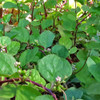Description
Red Malabar Spinach – Heat-Loving Leafy Green
A beautiful vining plant with gorgeous red stems and thick, dark green, heart-shaped leaves that climb 6-10' in warm climates. Malabar spinach loves the summer heat, producing loads of tender leafy greens from July through September or first frost. The entire plant is highly attractive with vibrant reddish-purple stems and deep, rich, reddish-green leaves adding a pop of color to the garden, salads, and sandwiches.
While not a true spinach, it is remarkably spinach-like in flavor with a slight peppery tinge of arugula and is better suited to summer growing than spinach since it loves hot weather. Young leaves are the most tender and mild flavored, while mature leaves are more succulent and better suited for thickening soups, gumbo, sauces, and stews.
Thrives in warm weather and is tolerant of heat and humidity, unlike true spinach. Easy to grow and amazingly free of any pests and diseases. We like to plant it along a fence as a trellis, making it easier to harvest young leaves while strolling down one side then the other. Makes an excellent shade and wind barrier once established on a trellis or fence.
Other names include basella, Ceylon spinach, climbing spinach, Surinam spinach, Indian spinach, slippery vegetable, Malabar nightshade, vine spinach, and vine vegetable.
Green Malabar spinach is the lighter, green cousin.
Uses
Ideal for soups, salads and stir-fries. Young leaves and tips are used like spinach in cooking and salad. In Japanese restaurants breaded and fried leaves are often served as appetizers.
The tender, young leaves are excellent as fresh, raw greens for salads, wraps, sandwiches, smoothies, and toppings for burgers. Harvest the youngest leaves from the tops of the vines. Clip the shoots and add them to stir-fries, quiche, curries, and pasta.
Growing Tip
In Zone 6 and colder, start seeds inside 6 weeks before the last frost to get a jump on greens production. Zones 7 and warmer can generally direct sow the week of the last frost, depending on the night-time temperatures that week. Soaking the seeds overnight before planting helps break dormancy and speed germination.
It can lag a bit until the weather warms up but growth will skyrocket once it reaches 80°F outside.
Rich, fertile soil produces many more leaves that are milder as they mature. Keep the soil moisture consistent to prevent energy being diverted to flower and seed production.
Learn More
From the soil to the seed to the food you eat - we'll help you grow your best garden!
2 Reviews
-
Malabar Spinach, red
I planted this variety in late June, 2017. Have never tried this before but with our temperatures here in Evansville, IN, the mid summers can get really hot and dry. Germination rate was very good. Also, this plant is a vining type that keeps on growing! I have pinched the vine, as I would with basil, and I continue to have a great harvest (it's currently late October). This spinach has a very 'earthy' taste and somewhat reminds me of a buttery beet flavor. It's very good picked fresh and added in a salad, steamed, or even pan fried! I look forward to planting this variety again next summer!
-
Just keeps growing
The Master Gardeners at the historic Francis Land House Heirloom Vegetable Garden in Virginia Beach, Virginia are providing feedback on the donated seeds. Our garden consists of 35 raised beds, each four feet by twenty feet. The garden receives full sun all day and is fertilized with a combination of compost and commercial organic fertilizer. This plant just kept growing, very attractive on a trellis. We allowed it to go to seed and noted volunteer plants already sprouting this fall.

















